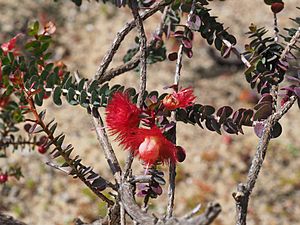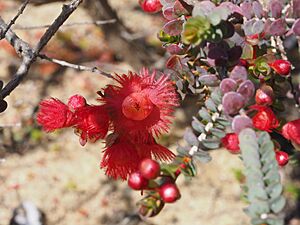Verticordia etheliana facts for kids
Quick facts for kids Verticordia etheliana |
|
|---|---|
 |
|
| V. etheliana var. etheliana growing in Kings Park, Perth | |
| Scientific classification | |
| Genus: |
Verticordia
|
| Species: |
etheliana
|
Verticordia etheliana is a beautiful flowering plant that belongs to the myrtle family, called Myrtaceae. You can only find this plant growing naturally in the south-west part of Western Australia. It's a type of shrub, which means it's a woody plant smaller than a tree. It has one main stem that branches out a lot. Its leaves are shaped like an egg or are almost round. The plant also has bright red flowers with greenish-cream centers that grow in groups, looking a bit like spikes.
Contents
What it Looks Like
Verticordia etheliana is a shrub that usually grows to be about 1 to 1.5 meters (3 to 5 feet) tall. It has a main stem that branches out many times near the ground, making the plant look quite full, though sometimes it can be more open.
The leaves of this plant are wide and can be egg-shaped, oval, or almost perfectly round. They are small, only about 2 to 6 millimeters (0.08 to 0.24 inches) long. Sometimes, the edges of the leaves have a few small, uneven teeth.
The flowers grow in groups that look like spikes. Each flower sits on a small stalk, about 3 to 10 millimeters (0.12 to 0.39 inches) long. The part of the flower that holds the petals and sepals, called the floral cup, is shaped like a top and is smooth. It has curved green parts attached to it.
The sepals (which are like small leaves that protect the flower bud) are bright red. They are often cream-green closer to their base. These sepals are about 7 to 10 millimeters (0.28 to 0.39 inches) long and have 8 to 16 feathery parts. The petals (the colorful parts of the flower) start out cream-colored or pink when they open. But they soon turn bright red. They are about 6 to 10 millimeters (0.24 to 0.39 inches) long and have a feathery edge. At their base, they have two ear-shaped parts.
The style (a part of the flower that helps with reproduction) is quite long, about 12 to 20 millimeters (0.47 to 0.79 inches). It curves gently and has simple hairs. It sticks out noticeably beyond the petals. This plant usually flowers from July to November or December.
How it Got its Name
The plant Verticordia etheliana was first officially described by a botanist named Charles Gardner in 1942. He published his description in a science journal called the Journal of the Royal Society of Western Australia. He used plant samples that were collected by William Blackall between "Yaringa" station and Northampton.
The second part of the plant's name, etheliana, was chosen to honor Ethel Gray Blackall. She was the wife of William Blackall, who collected the first plant samples used to describe the species.
In 1991, another botanist named Alex George looked closely at all the plants in the Verticordia group. He decided that Verticordia etheliana actually has two slightly different types, which he called varieties:
- Verticordia etheliana var. etheliana has leaves that are 3 to 6 millimeters (0.12 to 0.24 inches) long. Its flower stalks are 6 to 10 millimeters (0.24 to 0.39 inches) long. The sepals are 9 to 10 millimeters (0.35 to 0.39 inches) long, and the petals are 6 to 10 millimeters (0.24 to 0.39 inches) long. The style is 16 to 20 millimeters (0.63 to 0.79 inches) long.
- Verticordia etheliana var. formosa has shorter leaves, flower stalks, sepals, petals, and styles compared to the etheliana variety.
Where it Grows
This type of verticordia plant likes to grow in sandy, gravelly, or loamy soil. You can find it in areas with heath or shrubland. It grows between the Billabong Roadhouse and the Kalbarri National Park, and it can be found as far east as near Mullewa. These areas are part of the Avon Wheatbelt, Geraldton Sandplains, and Yalgoo regions in Western Australia.
Conservation Status
Good news! Both varieties of Verticordia etheliana are considered "not threatened" by the Western Australian Government's Department of Parks and Wildlife. This means they are not currently in danger of disappearing.
Growing in Gardens
Both types of Verticordia etheliana are very beautiful and eye-catching. People have tried to grow them in gardens because of their striking looks. However, it can be quite tricky to get them to grow and thrive outside of their natural habitat.


